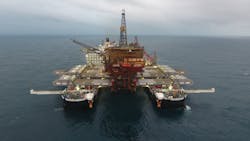Temporary changes to Norway’s petroleum taxation system have had an immediate effect, galvanizing field development in the North Sea. The benefits to the country’s supply chain should soften the impact of lower revenues caused by the government’s recent decision to cut production from certain fields by 250,000 b/d, in support of OPEC/OPEC+ measures to prop up the oil price. The restrictions, which do not apply to gas and condensate fields exporting to European markets, will remain in place until the end of the year.
Under the new measures, higher deductions apply to new offshore investments, reducing taxable profits for the next few years. Aker BP’s board was the first to respond, green-lighting a redevelopment of the Hod oilfield in the southern Norwegian North Sea that it had suspended in March when the oil price tumbled. The same wellhead platform alliance of Aker BP, Aker Solutions, and Kvaerner that completed the nearby Valhall Flank West project last year will supply the normally unmanned facility for Hod, which Kvaerner has started building at its yard in Verdal. The new wellhead platform should be shipped to the field next summer.
Shortly afterwards Aker BP, Equinor and Poland’s LOTOS reached an outline agreement for a potential new 500 MMboe-plus development tying in multiple stranded fields in the northern Norwegian North Sea. These are spread across licenses in the Krafla/Fulla region and the north of Alvheim Area (NOAKA). The current favored proposal is for a new processing platform in the south, operated by Aker BP; an unmanned processing facility in the north, operated by Equinor; and various interconnected satellite platforms and tiebacks. The partners will work jointly on a plan for development and operation, with priorities including optimizing costs (currently estimated at over $5.24 billion) and lowering the project’s carbon footprint via power from shore, and possibly offshore wind power for the Aker BP platform.
Equinor also credited the petroleum tax adjustments for its decision to pursue part-electrification of the Sleipner field complex, in partnership with Vår Energi, LOTOS, and KUFPEC. This will entail laying a new 28-km (17.4-mi) HV power cable from Sleipner to the Gina Krog platform in the Utsira High region, where a new area-wide power-from-shore scheme is planned, linked to Phase 2 of the Johan Sverdrup field development. Equinor estimates this will cut emissions of CO2 (carbon dioxide) from producing fields in the area by around 1.15 MM metric tons/yr (1.267 MM tons), with Sleipner’s share of the reduction over 150,000 metric tons (165,347 tons). The projected cost of the electrification works at Gina Krog/Sleipner is around $150 million.
Another prospective project is the subsea tieback of the large Breidablikk oil discovery to the Grane field platform in the North Sea. Equinor anticipates a final investment decision later this year.
Consortia plan North Sea CO2 stores
Maersk Drilling is joining a new consortium formed by INEOS and Wintershall Dea to pursue CO2 storage in disused oil and gas fields beneath the Danish North Sea. The program has support from the Danish Energy Agency, with the Geological Survey of Denmark and Greenland (GEUS) performing research, including laboratory experiments and analyses. The partners plan to build infrastructure to capture CO2 on land, potentially at industrial or power plants, which would be transported offshore for injection and storage at a subsurface depth of 1,700 m (5,577 ft) via repurposed oil and gas wells. Pending results of a feasibility study on reservoir compatibility and a planned CO2 injection test, the first well could be ready for injection from INEOS’ Nini platform in 2025. The longer-term goal is to develop storage capacity for around 3.5 MM metric tons/yr (3.85 MM tons) of CO2 by 2030, equivalent to 15-20% of Denmark’s total emissions reduction target set by the government and the Danish Climate Council. Maersk Drilling would supply rigs for the program, which it will also co-fund.
Earlier, Equinor, Shell, and Total submitted their plans for development and operation of the Northern Lights CO2 storage project in the Norwegian North Sea, with initial estimated costs of $673 million. It follows a successful exploration well last December on an area close to the Troll field which demonstrated that the sandstone reservoirs are capable of storing CO2. Phase 1 of the planned project will involve developing capacity to transport, store, and inject up to 1.5 MM metric tons/yr (1.65 MM tons) of CO2. This will be captured onshore at the Naturgassparken in western Norway and delivered by ships for injection and permanent storage at the offshore location, at a depth of 2,500 m (8,202 ft). Equinor’s facilities at the Sture terminal in Oygarden will remotely operate the onshore plant, while the subsea facilities will be controlled from the Oseberg A platform. If Norway’s government approves the scheme this year, it could be operational in 2024.
Allseas removes third Brent topsides
Allseas’ Pioneering Spirit has removed the third of four giant platform topsides from Shell’s Brent field complex in the UK northern North Sea. The Brent Alpha operation, which according to Allseas, involved 15 months of offshore preparations, included strengthening and cutting the steel jacket’s six legs for the 17,000-t lift, completed within 9 seconds. It was also the first offshore lift to employ specially-developed ‘horseshoes’ connection tools, designed to clamp around pre-installed lift points on the upper sections of the jacket legs. The 94-m (308-ft) tall, 42-m (138-ft) wide topsides, installed in the mid-1970s, comprised multiple decks with living quarters, power generation, process systems, drilling derrick, flare stack and other items. It has since been delivered to Able UK’s decommissioning yard in northeast England for recycling. The Pioneering Spirit has further platform removal jobs lined up this summer in the UK and Danish sectors.
Heerema Marine Contractors’ new flagship semisubmersible crane vessel Sleipnir is due to return this year to ConocoPhillips’ Ekofisk field to remove the jacket for the 2/4A platform, Norway’s oldest production platform until operations ceased in September 2013. In May the vessel extracted the topsides - originally installed by Heerema’s Champion in the early 1970s - comprising five modules, crane and burner booms - for recycling at the AFEBV site in Vats, Norway. Hereema has developed a subsea excavator to prepare the jacket for lifting.
In the UK southern gas basin, Dutch contractor Petrodec has removed the topsides from Perenco UK’s unmanned Pickerill A platform via a skidding operation onto the deck of the support vessel Energy Endeavour, which also completed P&A operations at the Pickerill field last year. This dual capability, for tasks normally performed by a drilling rig and a heavy-lift vessel, is unique to the industry, Petrodec claimed.
About the Author
Jeremy Beckman
Editor, Europe
Jeremy Beckman has been Editor Europe, Offshore since 1992. Prior to joining Offshore he was a freelance journalist for eight years, working for a variety of electronics, computing and scientific journals in the UK. He regularly writes news columns on trends and events both in the NW Europe offshore region and globally. He also writes features on developments and technology in exploration and production.

